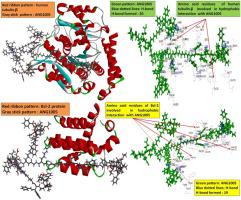当前位置:
X-MOL 学术
›
Semin. Cancer Biol.
›
论文详情
Our official English website, www.x-mol.net, welcomes your
feedback! (Note: you will need to create a separate account there.)
Nanotechnology, in silico and endocrine-based strategy for delivering paclitaxel and miRNA: Prospects for the therapeutic management of breast cancer.
Seminars in Cancer Biology ( IF 12.1 ) Pub Date : 2019-12-28 , DOI: 10.1016/j.semcancer.2019.12.022 Mohammad Azam Ansari 1 , Muthu Thiruvengadam 2 , Zeba Farooqui 3 , Govindaswamy Rajakumar 2 , Qazi Mohammad Sajid Jamal 4 , Mohammad A Alzohairy 5 , Ahmad Almatroudi 5 , Mohammad N Alomary 6 , Ill-Min Chung 2 , Ebtesam Abdullah Al-Suhaimi 7
Seminars in Cancer Biology ( IF 12.1 ) Pub Date : 2019-12-28 , DOI: 10.1016/j.semcancer.2019.12.022 Mohammad Azam Ansari 1 , Muthu Thiruvengadam 2 , Zeba Farooqui 3 , Govindaswamy Rajakumar 2 , Qazi Mohammad Sajid Jamal 4 , Mohammad A Alzohairy 5 , Ahmad Almatroudi 5 , Mohammad N Alomary 6 , Ill-Min Chung 2 , Ebtesam Abdullah Al-Suhaimi 7
Affiliation

|
Breast cancer is one of the most prevalent and reoccurring cancers and the second most common reason of death in women. Despite advancements in therapeutic strategies for breast cancer, early tumor recurrence and metastasis in patients indicate resistance to chemotherapeutic medicines, such as paclitaxel due to the abnormal expression of ER and EGF2 in breast cancer cells. Therefore, the development of alternatives to paclitaxel is urgently needed to overcome challenges involving drug resistance. An increasing number of studies has revealed miRNAs as novel natural alternative substances that play a crucial role in regulating several physiological processes and have a close, adverse association with several diseases, including breast cancer. Due to the therapeutic potential of miRNA and paclitaxel in cancer research, the current review focuses on the differential roles of various miRNAs in breast cancer development and treatment. miRNA delivery to a specific target site, the development of paclitaxel and miRNA formulations, and nanotechnological strategies for the delivery of nanopaclitaxel in the management of breast cancer are discussed. These strategies involve improving the cellular uptake and bioavailability and reducing the toxicity of free paclitaxel to achieve accumulation tumor site. Furthermore, a molecular docking study was performed to ascertain the enhanced anticancer activity of the nanoformulation of ANG1005 and Abraxane. An in silico analysis revealed that ANG1005 and Abraxane nanoformulations have superior and significantly enhanced interactions with the proteins α-tubulin and Bcl-2. Therefore, ANG1005 and Abraxane may be more suitable in the therapeutic management of breast cancer than the existing free paclitaxel. miRNAs can revert abnormal gene expression to normalcy; since miRNAs serve as tumor suppressors. Therefore, restoration of particular miRNAs levels as a replacement therapy may be an effective endocrine potential strategy for treating ER positive/ negative breast cancers.
中文翻译:

纳米技术,基于计算机和基于内分泌的紫杉醇和 miRNA 策略:乳腺癌治疗管理的前景。
乳腺癌是最普遍和复发的癌症之一,也是女性第二常见的死亡原因。尽管乳腺癌治疗策略取得了进展,但由于乳腺癌细胞中 ER 和 EGF2 的异常表达,患者的早期肿瘤复发和转移表明对化疗药物(例如紫杉醇)产生耐药性。因此,迫切需要开发紫杉醇的替代品以克服涉及耐药性的挑战。越来越多的研究表明,miRNA 是一种新型的天然替代物质,在调节多种生理过程中发挥着至关重要的作用,并且与包括乳腺癌在内的多种疾病密切相关。由于 miRNA 和紫杉醇在癌症研究中的治疗潜力,目前的综述侧重于各种 miRNA 在乳腺癌发展和治疗中的不同作用。讨论了将 miRNA 递送至特定靶位点、紫杉醇和 miRNA 制剂的开发,以及在乳腺癌治疗中递送纳米紫杉醇的纳米技术策略。这些策略包括提高细胞摄取和生物利用度并降低游离紫杉醇的毒性以实现肿瘤部位的积累。此外,还进行了分子对接研究,以确定 ANG1005 和 Abraxane 的纳米制剂增强的抗癌活性。计算机分析表明,ANG1005 和 Abraxane 纳米制剂与蛋白质 α-微管蛋白和 Bcl-2 具有优异且显着增强的相互作用。所以,ANG1005 和 Abraxane 可能比现有的游离紫杉醇更适合治疗乳腺癌。miRNA可以使异常基因表达恢复正常;因为 miRNA 作为肿瘤抑制因子。因此,恢复特定 miRNAs 水平作为替代疗法可能是治疗 ER 阳性/阴性乳腺癌的有效内分泌策略。
更新日期:2019-12-28
中文翻译:

纳米技术,基于计算机和基于内分泌的紫杉醇和 miRNA 策略:乳腺癌治疗管理的前景。
乳腺癌是最普遍和复发的癌症之一,也是女性第二常见的死亡原因。尽管乳腺癌治疗策略取得了进展,但由于乳腺癌细胞中 ER 和 EGF2 的异常表达,患者的早期肿瘤复发和转移表明对化疗药物(例如紫杉醇)产生耐药性。因此,迫切需要开发紫杉醇的替代品以克服涉及耐药性的挑战。越来越多的研究表明,miRNA 是一种新型的天然替代物质,在调节多种生理过程中发挥着至关重要的作用,并且与包括乳腺癌在内的多种疾病密切相关。由于 miRNA 和紫杉醇在癌症研究中的治疗潜力,目前的综述侧重于各种 miRNA 在乳腺癌发展和治疗中的不同作用。讨论了将 miRNA 递送至特定靶位点、紫杉醇和 miRNA 制剂的开发,以及在乳腺癌治疗中递送纳米紫杉醇的纳米技术策略。这些策略包括提高细胞摄取和生物利用度并降低游离紫杉醇的毒性以实现肿瘤部位的积累。此外,还进行了分子对接研究,以确定 ANG1005 和 Abraxane 的纳米制剂增强的抗癌活性。计算机分析表明,ANG1005 和 Abraxane 纳米制剂与蛋白质 α-微管蛋白和 Bcl-2 具有优异且显着增强的相互作用。所以,ANG1005 和 Abraxane 可能比现有的游离紫杉醇更适合治疗乳腺癌。miRNA可以使异常基因表达恢复正常;因为 miRNA 作为肿瘤抑制因子。因此,恢复特定 miRNAs 水平作为替代疗法可能是治疗 ER 阳性/阴性乳腺癌的有效内分泌策略。











































 京公网安备 11010802027423号
京公网安备 11010802027423号